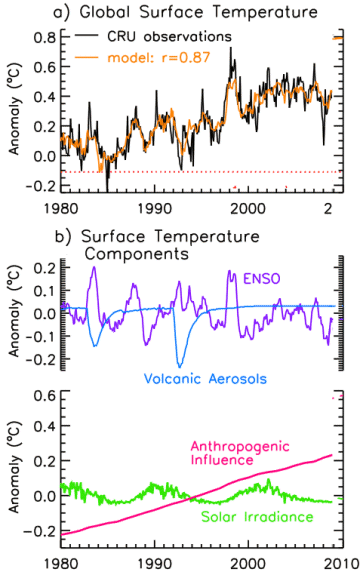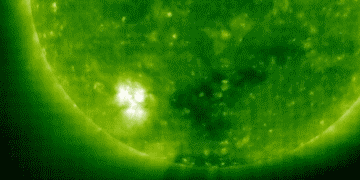
From 2002 to 2008, decreasing solar irradiance has countered much anthropogenic warming of Earth's surface. That's the conclusion of researchers Judith Lean (NRL) and David Rind (NASA/GISS), who have just published a new analysis of global temperatures in the Geophysical Research Letters. Lean and Rind considered four drivers of climate change: solar activity, volcanic eruptions, ENSO (El Nino), and the accumulation of greenhouse gases. The following plot shows how much each has contributed to the changing temperature of Earth's surface since 1980:
Volcanic aerosols are a source of cooling; ENSO and greenhouse gases cause heating; the solar cycle can go either way. When added together, these factors can account for 76% of the variance in Earth's surface temperature over the past ~30 years, according to the analysis of Lean and Rind.
Several aspects of their model attract attention: "The warmest year on record, 1998, coincides with the 'super-El Nino' of 1997-98," points out Lean. "The ESNO is capable of producing significant spikes in the temperature record." Solar minimum has the opposite effect: "A 0.1% decrease in the sun's irradiance has counteracted some of the warming action of greenhouse gases from 2002 - 2008," she notes. "This is the reason for the well-known 'flat' temperature trend of recent years."
What's next? Ultimately, the authors say, temperatures will begin rising again as greenhouse gases accumulate and solar activity resumes with the coming of the next solar cycle. Of couse, the solar cycle could be out of whack; if solar minimum deepens and persists, no one is certain what will happen. Lean and Rind reveal their predictions for the future here.
Reference: Lean, J. L., and D. H. Rind (2009), How will Earth's surface temperature change in future decades?, Geophys. Res. Lett., 36, L15708
(Source: www.spaceweather.com)

